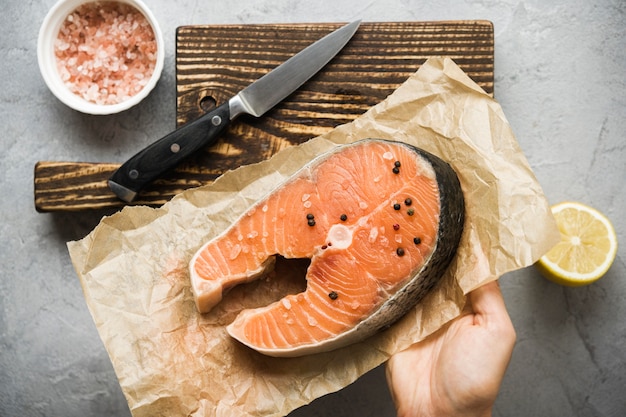Salmon cooked in a convection oven is simply scrumptious! If you’re craving a perfectly flaky and tender fish, this is the way to go. With the help of a convection oven, you can achieve a delectable dish in no time. In this guide, we’ll walk you through the steps to cook salmon in a convection oven like a pro.
From preparing the salmon to checking for doneness, we’ve got you covered. By following these simple directions, you’ll be able to serve up a mouthwatering meal that will impress your family and friends. So, let’s get cooking and enjoy the flavorsome goodness of salmon cooked in a convection oven!
How to Cook Salmon in Convection Oven?

Preparing the Salmon
- To prepare the salmon for cooking in the convection oven, start by seasoning it with salt, pepper, and olive oil. This simple step will add flavor and enhance the taste of the fish. You can also experiment with different marinating options, such as lemon juice or herbs, to further enhance the flavor profile. Once seasoned, place the salmon on a baking sheet lined with parchment paper or aluminum foil. This will prevent sticking and make cleanup easier.
- While the convection oven is a great method for cooking salmon, there are alternative cooking methods as well. Grilling or pan-searing are popular options that can give the salmon a delicious charred exterior and a moist, flaky interior. Choose the method that best suits your preferences and enjoy a perfectly cooked salmon dish.
Seasoning the Salmon
- Once you have prepared the salmon for cooking in the convection oven, it’s important to season it properly to enhance its flavor and ensure a delicious outcome. While traditional seasonings like salt, pepper, and lemon juice work well, there are also alternative seasonings that can add a unique twist to your dish. Consider using herbs like dill, parsley, or thyme to infuse your salmon with fresh and aromatic flavors.
- Additionally, marinating the salmon before cooking can further enhance its taste and tenderness. You can use a simple marinade of olive oil, garlic, and soy sauce, or experiment with different combinations of herbs, spices, and citrus juices. Just remember to let the salmon marinate for at least 30 minutes to allow the flavors to penetrate the fish.
Preheating the Convection Oven
- To ensure optimal cooking results, preheat the convection oven before cooking the salmon. Using a convection oven for cooking salmon offers several benefits. First, the convection fan helps to distribute heat evenly, resulting in a more uniform cooking process. This ensures that your salmon is cooked to perfection, with a crispy exterior and a moist, tender interior. Additionally, the convection oven’s faster cooking time allows you to enjoy your salmon in less time.
- There are different methods to preheat a convection oven for cooking salmon. One method is to simply set the oven to the desired temperature and allow it to preheat for about 10-15 minutes. Another method is to preheat the oven to a higher temperature, then reduce it to the desired cooking temperature once the salmon is placed inside. Whichever method you choose, preheating the convection oven is essential for achieving the best results when cooking salmon.
Placing the Salmon in the Oven
- Now, you can place the salmon in the oven. Before doing so, make sure the oven is preheated to the recommended temperature. This ensures that the salmon cooks evenly and thoroughly. The cooking time will vary depending on the size and thickness of the salmon fillet. As a general guideline, cook the salmon for about 12-15 minutes per inch of thickness.
- To check if it’s done, insert a fork into the thickest part of the fillet. If it flakes easily and is opaque in the center, it’s ready to be taken out of the oven. Remember, overcooking can result in dry and tough salmon, so keep an eye on it and remove it promptly when it’s done.
Checking for Doneness
- To ensure that your salmon is cooked to perfection, you can now check for doneness. Start by checking the internal temperature of the fish. For a medium-rare salmon, the temperature should read around 125°F (52°C), while a medium to medium-well salmon should be around 130-145°F (54-63°C). Use a digital meat thermometer to accurately measure the temperature.
- Another way to check for doneness is by testing the fish for flakiness. Gently press a fork into the thickest part of the salmon and twist it slightly. If the fish flakes easily and is opaque throughout, it’s cooked. Avoid overcooking the salmon, as it can lead to dryness. With these simple techniques, you can ensure that your salmon is perfectly cooked and ready to enjoy.
Conclusion
In conclusion, cooking salmon in a convection oven is a simple and delicious way to enjoy this flavorful fish. By properly preparing and seasoning the salmon, preheating the oven, and checking for doneness, you can ensure a perfectly cooked result. The convection oven’s efficient circulation of hot air will cook the salmon evenly and enhance its natural flavors. Follow these steps and enjoy a mouthwatering salmon dish that will impress your family and friends.


